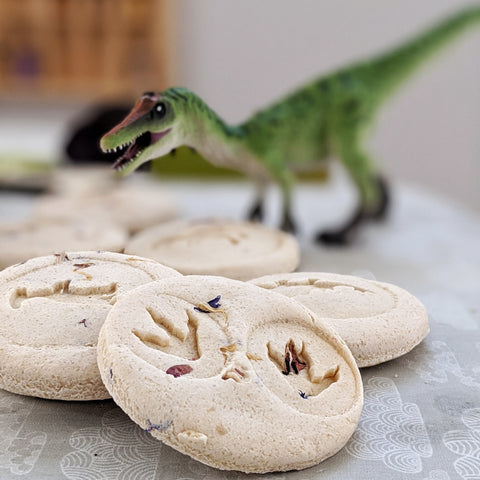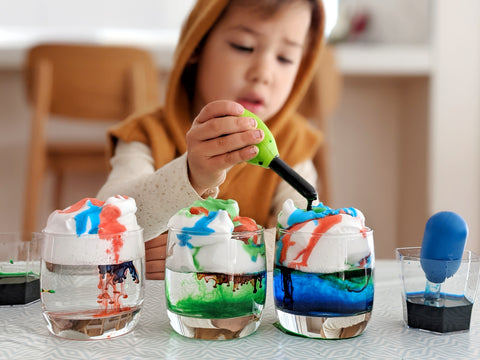
As a busy Mum with a curious little one, you're likely always looking for ways to keep your little one engaged, entertained, and learning!
I remember the days when Benji was younger, and I was looking
for activities that were engaging and fun for him but also for me. Because- honestly, my patience to build garages or be a superhero is limited. My answer to the quest was STEAM activities!
STEAM stands for Science, Technology, Engineering, Arts, and Math.
This multidisciplinary framework encourages children to explore, create, and learn
through hands-on experiences. This exciting blend of subjects fuels their intellectual curiosity and improves essential skills that will serve as building blocks for their future success.
STEAM play isn’t just educational; it’s also incredibly fun and can be easily conducted in your home. It might sound overwhelming and complicated, but it really isn’t!
In this blog, we'll explore some fantastic STEAM activities that captivate your toddler's imagination and lay the foundation for a lifelong love of learning.
Colourful Rainbow Volcano (Science & Art)
Turn a science experiment into an art project with this colourful volcano eruption. Create a simple volcano using modeling clay or playdough (you can use a small empty bottle as the base if you’d like), and place it on a tray.
Pour baking soda into the volcano and add a few drops of food coloring.
Then, ask your child to pour vinegar into the volcano, and watch
it erupt with a vibrant rainbow explosion. Benji was mesmerised by the colourful eruption. It’s not just exciting! They'll also learn about chemical reactions and coluor mixing. Benji loved this as a toddler and still loves it now. Even the big kids in my class still get excited about this one.
Building with Everyday Items (Engineering & Math)
Children are natural engineers, constantly experimenting with how things fit together. Collect everyday items like cardboard boxes and offer the tools from the Makedo sets. Encourage your toddler to build structures using these items. Talk to them about shapes, sizes, and balance as they construct their masterpiece.
You can introduce basic math concepts by counting sides and pieces or discussing which structure is taller or shorter. If you want to add some art, you can paint your creations afterward. In our house, garages and robots are super loved. Or a castle if we're lucky enough to score a big box!
Rain in a Jar
All you need for this weather science activity is a cup of water, shaving cream, and blue food colouring. Watch as the blue food coloring falls through the clouds and looks like rain when it travels through the water.
In this experiment, we make clouds with the shaving cream and the food-coloured water is rain. As you drop the colored water into the cloud, the weight of the water forces itself through the cloud to form colourful rain into the jar.
Take cold water in a jar and fill it to 3/4 level. Add shaving foam on top of the cold water and then mix some food colouring in the water and keep aside.
Take a pipette or dropper and keep adding the coloured water to the foam gradually. Eventually, the foam cannot hold the water anymore, and the coloured water trickles down as rain.
This experiment gives children a very simplistic view of how rain happens. It is visually exciting for kids to see the coloured water trickling down. You might want to keep rainbow colours with you as Benji wanted to experiment with all colours and create rainbow rain.
Nature Scavenger Hunt (Science & Observation)
Explore the world outside with a nature scavenger hunt. Use the Nature Treasure Hunt board or create a checklist of items commonly found in your backyard or local park – leaves, rocks, flowers, insects, etc.
Provide your child a small basket and help them search for these items. Along the way, converse about different textures, colours, and shapes. This activity enhances observation skills and nurtures a love for the natural world.
Later you could craft with these items or pop flowers into a flower press.


Magnetic Marvels: Toddler-Friendly Magnet Exploration (Science & Engineering)
Magnetism is a fascinating natural phenomenon that can captivate even the youngest minds. Introducing your toddler to magnets through a hands-on exploration activity is incredibly engaging.
It provides a beautiful opportunity to introduce basic concepts of science and engineering. Start by gathering an assortment of magnets from around the house. This could include refrigerator magnets, magnetic letters, and small magnetic toys. Lay them out on a table in front of your child.
Place a variety of non-magnetic objects alongside the magnets. These could be plastic toys, wooden blocks, paper clips, cotton balls, or anything else you have on hand.
Encourage them to explore the objects and magnets. Talk about how magnets have a special force that can attract certain objects. Invite them to test each object by placing the magnet/magnetic wand near it and observing whether
it sticks or is attracted to the magnet. Help them to sort the objects into two categories: "Sticks to the Magnet" and "Doesn't stick to the Magnet."
Sensory Bin Creations (Art & Science)
Sensory bins or trays are a fantastic way to engage children's senses while introducing them to different materials and textures. Fill a bin with rice, sand, water
beads, or dried pasta. Add small toys/items like pom poms or metal rimmed counting chips, scoops, and cups/bowls, and let your toddler explore and create to their heart's content.
This hands-on experience fosters creativity and scientific curiosity as they experiment with different combinations and textures. We love using the treasures we found during the scavenger hunt in these too.
See our full range of sensory play resources here.


Read the blog: Sensory Play; What to do and When for more ideas.
Sink or Float Experiment (Science & Critical Thinking)
Fill a basin or bath with water and gather an assortment of objects from around the house – think buttons, rubber bands, toy cars, and foam blocks.
Invite your child to predict whether each object will sink or float before dropping them into the water.
This hands-on experiment introduces basic principles of buoyancy and
encourages critical thinking as your toddler tests their hypotheses.
You could also take this activity outdoors and use nature such as leaves, sticks, feathers and rocks.

Salt Dough Dino Fossils (Art & Science)

This is, without a doubt, one of our most used activities. When in doubt – go for salt dough. We use the fossils in the sandpit to dig up as treasures. We sell them as cookies in our shop and play memory with them. So it's not only a fun activity, but you also have a great resource. All you need is some salt dough and small toy dinosaurs. It’s so easy.
Materials Required:
- Small toy dinosaurs
- 1/2 Cup of salt
- 1/2 Cup of warm water
- 1 Cup of flour
- Rolling pin
- Large mixing bowl
- Baking tray
- Circle cookie cutter
- Parchment paper

Step 1: Crafting the Salt Dough
Combine the salt and flour in a spacious mixing bowl, and then introduce the warm water.
To enhance the dough's consistency, use a kettle to boil and heat water. This hot water assists in dissolving the salt and contributes to the dough forming a smoother texture. Thoroughly blend these ingredients until they combine into a dough-like consistency.
Step 2: Forming Dinosaur Fossils
Create balls and gently flatten them. Big and thick enough to press the dino figures into the dough.
Gently press the sides of your miniature dinosaur toys into the center of each salt dough circle.
Step 3: Baking the Dough
Begin by preheating your oven to 90 degrees.
Cover a cookie sheet with a sheet of baking paper and carefully arrange the salt dough fossils. Allow the fossils to bake for approximately an hour. Once the baking process is complete, let the fossils cool down before painting or playing.
I hope you enjoyed reading our STEAM ideas, and will be incorporating some STEAM activities into your daily play. It really doesn't require extravagant setups or special equipment. With just a bit of creativity and some household items, you can offer your child engaging opportunities to explore science, technology, engineering, arts, and math.
These activities aren't just about learning; they're about fostering curiosity, nurturing creativity, and spending quality time together. So, dive into the world of STEAM with your little one and watch as their eyes light up with wonder and excitement.
Have fun playing!
Written by Lisa @labrinths.and.lovehearts







